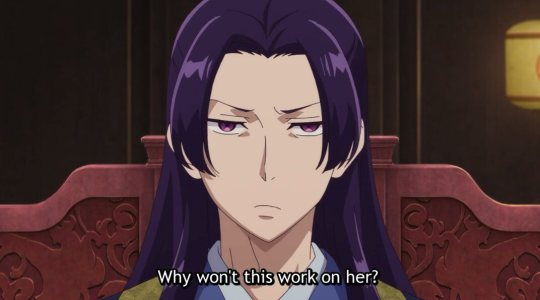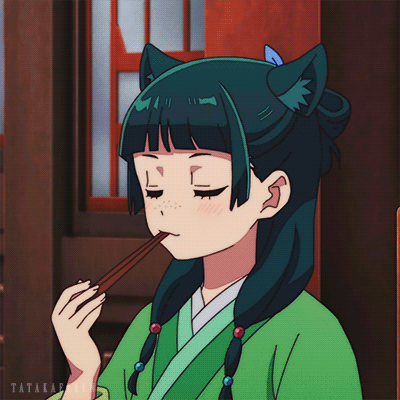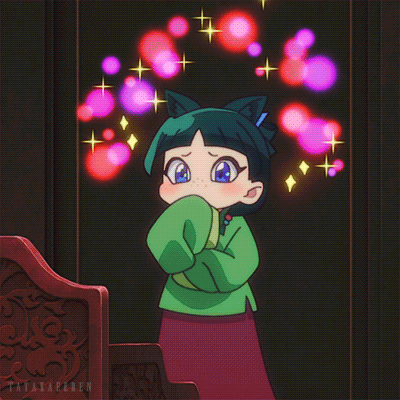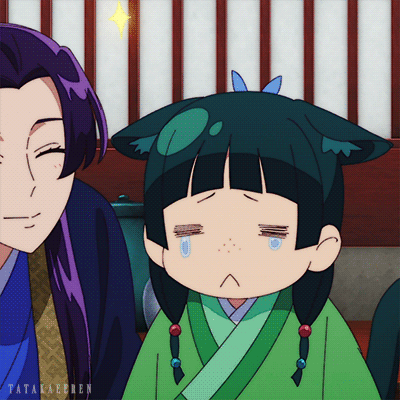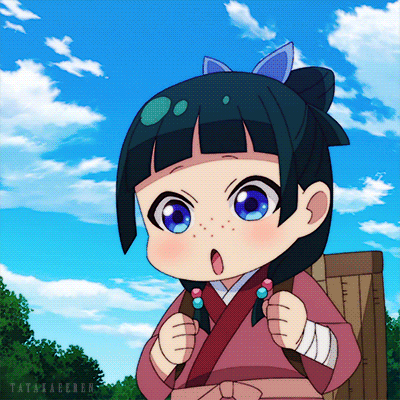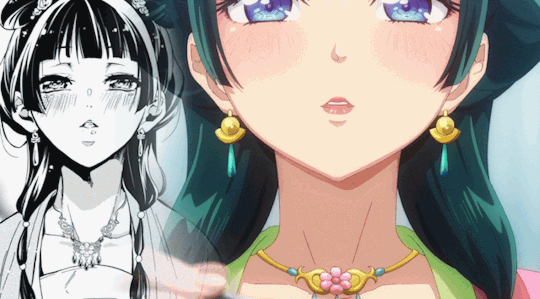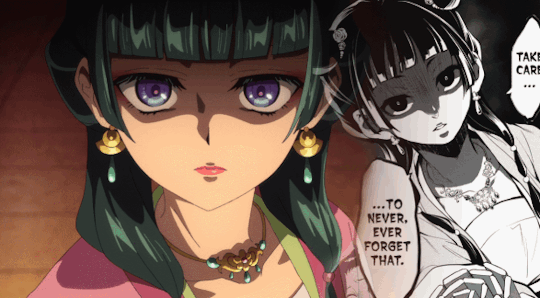Text
one thing i really like about the apothecary diaries is how fluidly maomao moves between high- and low-class society, between the rear palace and the pleasure district, allowing us to see the parallels in the power dynamics. in both settings, we see women trying to make the most of their relative stations with whatever tools available to them, which are often shared. much of the politics of the series centers women and the ways they try to navigate the world through seduction, marriage, beauty, fashion, manipulation, etc, because these are the things they're valued for. their appearance, their social graces, their "purity", their marriageability, their ability to bear children, and beyond - these all lend political, economic, and social leverage to themselves and their families regardless of class.
the mystery angle in particular enables the story to closely examine what tools and motives are available to women in the apothecary diaries in a way that's contextualized and humanized. it's also how the series highlights said women operating with a keen awareness of society's expectations and systems. whether that's applying deathly white powder to maintain impractical beauty standards, faking illnesses to deter certain visitors, using parlor tricks to subtly punish callous men, or wearing ostentatious outfits to hide a certain truth, each mystery we encounter reveals more about what it means to navigate the world of the apothecary diaries as a woman in addition to revealing their cleverness (or lack thereof) in doing so.
maomao is no exception to the rule, often weighing similar questions of propriety and power before she acts - although she does engage from a unique position. she's a literate woman from the lower class with special circumstances surrounding her birth, versed as an apothecary, and favored by highly ranked members of the court. this, plus her marked lack of ambition beyond medicine, gives her a lot of mobility between and (relatively) unbiased insight into both the high- and low-ranked parts of society. in turn, we readers are given a fantastic protagonist to explore what i consider a core draw of the series: seeing how maomao chooses to move through the world, highly conscious of her own social positioning as well as that of all the other women around her
1K notes
·
View notes
Text

The Kusuriya no Hitorigoto anime is great, but God does the opening crack me up. You get a minute of this girl tarted up and dancing but when the story is actually on she's like


She is so salty they made her walk the gutter.
4K notes
·
View notes
Text
youtube
This opening is replete with symbolism.
Flower language has been a recent fascination of mine.
Do you want to make my new hyperfixation your problem? If so, then let's take a deep dive into the first opening before the new one airs tomorrow.
Before I start, here are a couple of things to keep in mind.
While the use of flower language in this show mostly lines up with Japanese hanakotoba, there are still a number of flowers here that hold particular significance within Chinese culture, and thus have additional meanings that don't line up with those from Japan. I’ll be mentioning them alongside the Japanese meanings where I deem it relevant.
The following will contain light spoilers of content from the novels/manga which has not been animated at the time of writing. I'll try to be vague and sparing with it, but there are a few flowers I can't discuss without them.
Past the title card, the opening begins with eight blooming flowers dancing through the frame in rapid succession. These represent the storylines covered by the first cour of the anime in order of appearance, and each can be found in the episode(s) they signify. From the top:
Rhododendron: This plant is all over the first two episodes, so I'm going to cover its appearances before delving into its meaning. In episode one, there are two shots of the buds of this plant, one as Lihua gives birth, and then again as the doctor examines her baby. They're finally shown in full bloom as one of her ladies disregards the branch Maomao used to warn of the toxic makeup. In the following episode, Gyokuyou has seemingly taken a liking to the flower that saved her daughter's life, and a few clusters can be seen in a vase during several shot before Maomao uses them as an example of a seemingly innocuous plant that could cause accidental poisoning, and indeed, if you look closely at the background during the scene with the soldiers, you can see what appear to be rhododendron shrubs. There are actually quite a few different possible meanings for the many granular varieties of Rhododendrons/azaleas. Luckily, the characters said the name of the plant out loud for me: shakunage. So, this is Rhododendron subg. Hymenanthes. In hanakotoba, it means dignity and majesty, but also, on account of its poison, danger and caution. Those last two meanings clearly line up with its ominous usage in these first episodes, growing and maturing as the babies grow sicker. But in addition to their function as a warning of danger, I think there's a case to be made that they also represent Gyokuyou herself. As I stated earlier, she starts keeping them after the first episode, and Hongniang later starts growing the closely-related azaleas in the jade pavilion as well. As for how its meanings apply to her, Gyokuyou is regal, magnanimous, and never loses her composure (unless it's at Jinshi's expense lol,) but she's also described by Gaoshun as shrewd and cautious, being unwilling to hire any lady she doesn't absolutely trust, and constantly gleaning information to send back to her family. These all fit with the dual meanings of rhododendron. In Chinese culture, rhododendrons and azaleas represent womanhood and passion, as well as home and a desire for homecoming.
Cotton rose: A type of hibiscus, this represents Fuyou, decorating both her person and her chambers in episode 3. It means 'delicate beauty' and 'graceful lover.' I think these are referring to both her skill in dancing, as well as her affectation of frailty and neuroticism. As far as I could dig up, its unique tendency to change color based on the time of day doesn't have particular bearing on its meaning in either Chinese or Japanese culture, but the story itself uses it as a metaphor for Fuyou hiding her passion, will, and cunning behind a wallflower exterior.
Balloon flower: In hanakotoba, it represents undying love, sincerity, and grace. These grow in the crystal pavilion, adorn the iconography of Lihua's furniture, and likely inform her blue and violet color scheme. Its last two descriptors gesture towards Lihua's style and personality. She's elegant and staid, but she also takes everything quite seriously, and wears her heart on her sleeve. As for the undying love element, I see that as alluding to her love for her son, her agony at his passing, and her hopes of reclaiming that love again through having another child.
Violet: This one actually tripped me up for the longest time. The flowers in the opening looked like hostas to me, but no matter how closely I looked at the backgrounds in this show, I couldn’t find anything along those lines. Eventually though, I caught on that these must be the violets from episode five, even if they’re a different color from those shown in the episode. And also droopier. Anyway, violets mean humility, sincerity, and ‘a little bit of happiness.’ In the episode proper, they are crushed underfoot as Maomao narrates about the lengths she had to go to keep herself safe while growing up in the red-light district, illustrating how even the modest aspirations of an ordinary peasant are in perpetual danger in such a cutthroat environment.
Chinese aster: Daisies and asters are my least favorite flowers to identify. They all look the same. As such, I’m a little less confident about this one, but I think it’s a Chinese aster. The leaves and buds look similar, and the context in which it appears in episode six suits its meaning. As Lishu’s ladies disparage her so-called pickiness, a shot of this flower opens the episode. While the Chinese aster’s meaning changes based on color, white in particular means ‘please believe me.’ I think that speaks for itself
Toad lily: This appears twice during episode eight, where Maomao gets drawn into the mystery of an attempted murder during her vacation. Toad lilies symbolize hidden thoughts and intentions, alluding both to the possible conspiracy on the part of the women of the brothel, and to the fact that Maomao will never really know the truth of the incident, having to content herself with speculation.
Sacred bamboo: This one is easy to miss, because while the plant is in full bloom in the opening, it’s laden with berries in the show proper. This is Nandina, a.k.a. the sacred bamboo, a mainstay of autumn and winter floral arrangements in both China and Japan. It’s considered auspicious, symbolizing a reversal of ill fortune into prosperity--the precise opposite of how it’s presented in episode nine of the show. There, Maomao fiddles with the plant as she contemplates all the instances she’s seen of good fortune being struck down by tragedy, and the prospect of that same sword of Damocles falling upon her head as well, a harbinger of eucatasrophe being used to symbolize straight catastrophe. Also worth noting is the fact that the plant is very poisonous, so much so that it has a reputation for killing any birds which try to eat its berries; I think that bit of trivia might be the inspiration behind the decision to ironically invert its lucky image. In addition to its central appearance in episode nine, it can also be seen in Lishu’s chambers in episode ten, mixed in among the vases of white camellias.
Japanese azalea: These mean passion and steadfastness, alluding, in my view, to Fengming’s devotion towards Ah-duo. Fun fact: did you know that honey made from toxic azaleas, termed ‘mad honey,’ is sometimes manufactured on purpose? It’s not super legal in most of the world, but apparently it can be used as a psychedelic.
After this, we see a panning shot of seven flowers, with the top four representing the high-ranking concubines, and the bottom three representing the high-ranking courtesans. While the first set of flowers grew from buds and flew across the screen, this set consists of still images. If I were to hazard a guess as to why, I'd say that it's because those previous flowers were conveying the movement of emergent stories, while these upcoming flowers portray the relatively static personality traits of individual characters. I'm going to tackle these in reverse order, as the first three flowers to appear are somewhat tricky to talk about.
Peony: This flower represents Gyokuyou, and in addition to appearing in her non-diegetic floral backgrounds, it also decorates the tapestries of the jade pavilion. In Chinese culture, peonies are one of, if not the most, important flowers. They represent feminine beauty, pride, honor, renown, wealth, prosperity, high-status, opulence, and a nobility of spirit. They are considered to be the king of flowers, and were historically only permitted to be grown by nobility. All of these superlatives are likely alluding towards Gyokuyou's status as the emperor's favorite consort, with the best shot at becoming empress.
Balloon flower: See above.
Lily-of-the-valley: This means 'purity,' 'chastity,' 'humility,' and 'happiness will come again.' While the first three all seem to fit Lishu on their face, I find myself curious about the fourth meaning. I'm only partway through the third novel, but if this indicates that, at some point in the future, Lishu finally catches a break, then I'll certainly be happy to see it.
Dendrobium: In China, orchids in general are associated with elegance, refinement, and good taste, which fits with Maomao's description of the garnet pavilion as being beautiful in a minimalist sort of way. They also represent the virtues of an ideal gentleman-scholar: integrity, humility, temperance, and nobility. Furthermore, they are considered emblematic of spring; it, along with bamboo, chrysanthemum, and plum blossom, represent the four seasons. Returning to Japanese symbolism, the flower associated with Ah-duo seems to specifically be Dendrobium nobile. Nobile in particular means 'honest and to-the-point' in hanakotoba, likely alluding to Ah-duo's candid personality, and the fact that she is on casual terms with the emperor.
Regarding the final three flowers, the show itself doesn't explicitly tie any one of them to a particular courtesan--their flowers only appear as a group in episode twelve. But, by contemplating their meanings, and with some help from the characters' wiki pages, we can make some educated guesses.
Yulan Magnolia: This one, I'm guessing, represents Joka. On one hand, I'm kind of dumping her with this because the other two flowers just seem to fit the other two courtesans better, but its attributes nonetheless seem to accord what we know of her character--which admittedly isn't very much. In hanakotoba the yulan magnolia means nobility, sublimity and a love of nature. In China, its pretty similar: purity, nobility, dignity. It's also worth noting that they're commonly planted around Buddhist temples in China, and have been for many centuries, granting them an air of spiritual profundity. Joka is said to be aloof and cold, which is part of her appeal as a courtesan. While chrysanthemums and plum blossoms have a warmer aspect to their meanings, the loftiness of magnolia hews more closely to her characterization. Then there's the matter of her name, which is apparently a stage name. It translates to 'Lady Ka' (or 'Hua,' if you want to go with the Mandarin pronunciation.) Now, the 'ka' in her name is written as 華, and in the story, that character is only permitted to be used by the emperor and his family. So, for her to use it, even as a stage name, is a pretty bold pretense to nobility.
Chrysanthemum: In Japan, chrysanthemums are associated with nobility and the imperial family. In China, they are associated with longevity, endurance, and vitality, on account of their long-lasting blooms that persist late into autumn. I think this is most likely to be Pairin's flower. She's one of the few courtesans who's in her line of work because she wants to be, and is flourishing in an environment where others are desperate and debt-ridden. That covers 'vitality,' and Lihaku can attest to her endurance, if you know what I mean... Moving on, its mentioned in the novels that she's actually in her thirties, but still looks quite young, again harkening to the chrysanthemum's persistence.
As far as symbolism is concerned, chrysanthemums do seem to fit her character better than magnolias. But, something that gives me pause is her name, which means 'white bell,' on account of yulan magnolias being white and having a bell-like shape. I still think it's most likely that the chrysanthemum, and not the magnolia, belongs to her, but it was too notable a coincidence to not at least mention.
Plum Blossom: We can safely assume this one refers to Meimei, as her name is written with the character for plum. As plum trees are among the earliest to bloom each year, and will even bloom while snow still covers their branches, both China and Japan associate them with resilience, hope, inner-strength, and renewal. We don't know much about Meimei either, but my impression of her is that she seems to be the nicest and most even-keeled of Maomao's sisters.
Following this parade of showy flowers, we finally glimpse the emblem of our protagonist, Oxalis corniculata, the creeping wood sorrel, downcast and huddled amidst the underbrush of a forest. Whereas the other flowers we've seen thus far are primarily ornamental (even if some are also edible/medicinal,) wood sorrel is herbaceous and weedy, and is unlikely to grace any vases, wreaths, or arrangements. If it were spotted in a noble's garden, it would likely be uprooted, but to the peasant who finds it growing in a ditch, it's a tasty snack.
In hanakotoba, wood sorrel means joy, 'shining heart,' and 'a mother's love.' All three descriptors, I believe, are relevant to Maomao's character. Despite her flat affect, Maomao has a strong passion and sense of joie de vivre driving her through life. Those further along in either the novels or the manga will recognize 'a mother's love' as (somewhat ironically) gesturing towards her complicated relationship with her mother. As for 'shining heart,' I think that will become apparent as we go further through the opening.
But, before we do that, I'd like to take a moment to examine the moments when wood sorrel appears in the show itself. Thus far, by my recollection, it has appeared in episodes one, three, and twelve. The opening shot of the first episode is of a wood sorrel, informing the viewer in no uncertain terms that this is Maomao's flower, (in case the opening was too subtle.) In the third episode, several wood sorrels dot the field where Fuyou sits with her lover, symbolizing how Maomao has aided and protected them. In episode twelve, a single wood sorrel is tucked inside a lavish bouquet of her sister's flowers, a visual gag paralleling them fussing and fawning over her.
Returning to the opening, Maomao is shown contemplating a subtle glow in her closed hands while a reflected, sunlit version of herself glances back at her. Then, as all the previous flowers fall away, as Maomao casts the light up into the air, its glow illuminating her face, the wood sorrel finally stands upright, and blooms in full.
Now is a good time to mention a relevant characteristic of creeping wood sorrel: it only blooms in direct sunlight. When crowded by other plants, it curls in on itself, closing both its flower and leaves. This serves as a clear metaphor for Maomao's personality; under most circumstances, she seeks to be invisible and unobtrusive, but when she's in her element, she commands attention and respect.
Following this, we have her magical girl-esque transformation sequence, with her outstretched hands forming the shape of a blooming flower as she dances through a whirl of yellow wood sorrel petals. She then bows down in imitation of the flower, taking the light back into her chest (there's that shining heart I mentioned earlier,) as she dissolves into the stoic, unassuming version of herself once more, closing out the opening. (Jinshi who?)
I'd like to end this analysis with an observation. While the real wood sorrel exists at the perpetual mercy of outside forces, Maomao is not merely reacting to a light source that exists beyond her control. The light exists within her, and she chooses when it will shine down for all to see, and when she will hide it away in the depths of her heart. To those who've gotten this far, thank you so much for reading.
181 notes
·
View notes
Text




Tony Stark dies today (17/10/23), according to the MCU timeline.
7K notes
·
View notes
Text

no one asked me for a stylized version of shadowheart but i did it anyway and i have no explanations why ( ・ᴗ・̥̥̥ )
2K notes
·
View notes
Photo
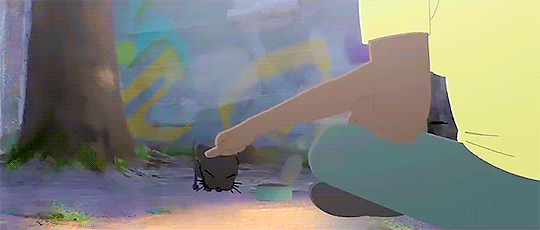

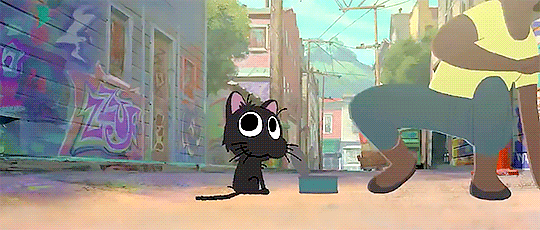

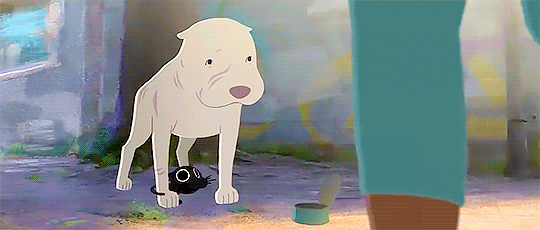

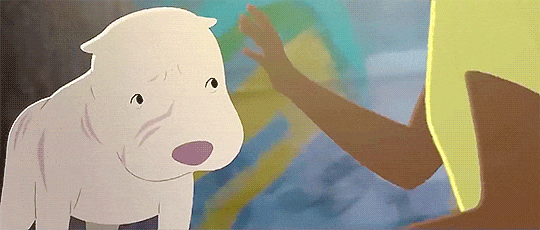
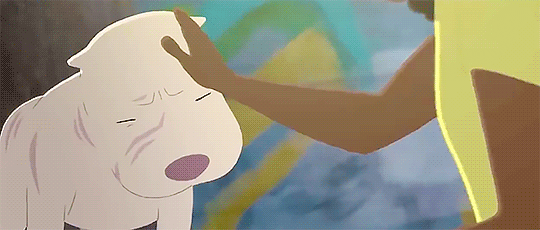
pit bulls aren’t evil. they just want to be loved.
313K notes
·
View notes
Photo


8K notes
·
View notes


